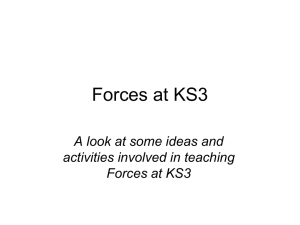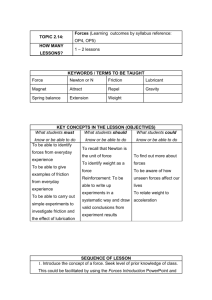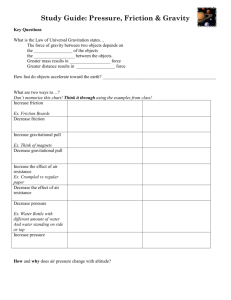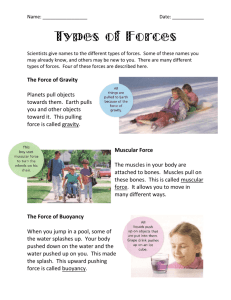What will be in the exam?
advertisement
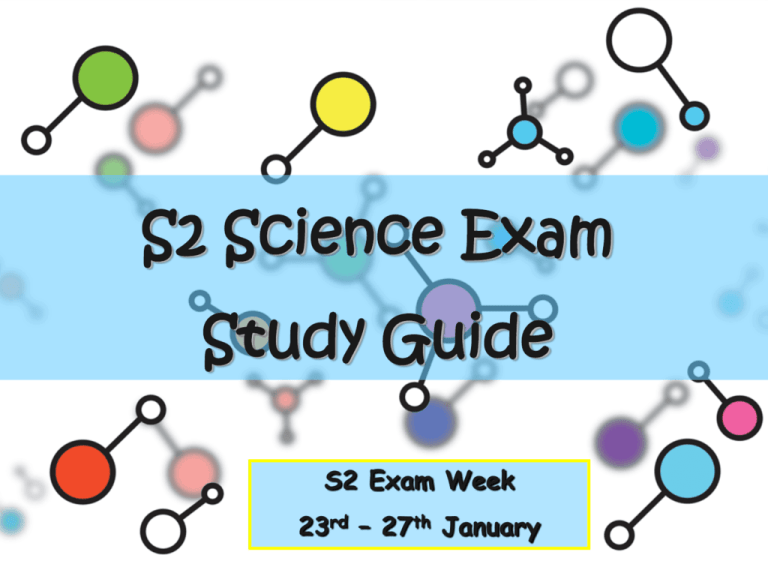
S2 Science Exam Study Guide S2 Exam Week 23rd – 27th January 02What will be in the exam? Your Science exam will cover all of the topics you have studied so far in S2: • Body Systems • Earth & Water • Forces • Numeracy and graph skills What will the exam be like? The 40 mark paper will be made up of 3 sections: Section A: Multiple Choice Questions Section B: Short answer questions Section C: A choice of three questions Study Guide Top 5 tips: 1. 2. 3. 4. Check the learning outcomes for each unit (found on next three slides) See your teacher about any you are unsure of For each unit try to write a short note about each learning outcome, this can be done in a number of ways: On study cards In your notebook or on paper As a mind map or poster Review your homework jotter and work on any corrections, all homework exercises can be found on the S2 Science Glow page 5. Practice drawing graphs and calculations Body Systems What you should know… Breathing System Know the structure and function of the breathing system Know the differences in the composition of inhaled and exhaled air Know the effects of exercise on breathing rate, and why this happens Know about how the lungs are kept clean and what smoking does to the lungs Digestive System Know the structure and function of the digestive system Know the main food groups and their functions Know how to carry out food tests for starch ,sugar and protein Know that the energy value (kJ per gram) of different foods varies Know the role of enzymes in digestion Know what happens to digested food and undigested food Know what is meant by a balanced diet and the health risks of a poor diet Nervous system Know the structure and function of the nervous system Know the three main parts of the brain and the main functions of these Know that the brain receives signals from the senses, controls movement and stores information Know about the health risks to the nervous system – drugs, alcohol, physical damage through accidents Circulatory System Know the structure and function of the circulatory system Know about the structure of the heart Know about the volume and composition of blood and what substances are carried in it Know the effect of exercise on heart rate Understand the concept of respiration, and the link between respiration, breathing, digestion and circulation Know about the major health risks associated with circulatory diseases Earth & Water What you should be able to do… 1. WATER Be able to describe the three states of water and the temperatures at which each occurs Be able to describe the water cycle Be able to describe the terms solute, solvent and solution, soluble, insoluble and saturated Be able to identify materials which dissolve in water and those which do not Be able to explain that different substances have different solubility Be able to explain that the solubility of a substance can depend on temperature Be able to use various solvents to identify which one is the best at dissolving a certain material Be able to describe three ways of speeding up the dissolving of a substance Be able to differentiate between pure substances and mixtures Be able to describe four methods of separating a mixture into its components 2. pH Be able to describe that the pH scale is a measure of acidity/alkalinity of various solutions and use the pH scale to measure the pH of everyday solutions Be able to find the effects of acids/bases on universal indicator paper Be able to describe three methods of measuring pH Be able to explain that neutral solution are neither acid or alkaline Be able to investigate every day examples of neutralisation Be able to explain how a new substance is formed when an acid is neutralised by an alkali by stating the reactants and products of the neutralisation reaction. Be able to make, collect and test the pH of carbon dioxide and observe the making and testing of nitrogen dioxide and sulphur dioxide 3. EARTH Be able to name the different parts of the Earth Be able to identify different rocks from their texture, colour or appearance e.g. marble, slate, chalk, sandstone Be able to describe how igneous rocks are formed Be able to explain how the impact of weather, climate and the movement of water/strong winds affect the shape of rocks Be able to name various rocks and what they are used for Be able to describe how an earthquake is produced Be able to describe how volcanoes are formed Be able to participate in the Rock Salt investigation Forces What you should be able to do… 1. 2. 3. 4. Represent a force using arrows in simple situations. Name common types of contact forces and the situations in which they occur (friction, upthrust, tension and supporting forces). Identify situations involving pushing, pulling and twisting forces. Name different types of non-contact forces and the situations in which they occur (electric force, magnetic force, force of gravity). 5. State that friction is a force which tries to stop an object moving or slow it down. 6. Recognise situations in which friction occurs and factors that increase or decrease friction (air friction, streamlining, and lubrication). 7. Explain that an object apparently weighs less in water because water produces upthrust (buoyancy force). 8. Carry out investigations which demonstrate effects of density on floating/sinking. 9. State that electrical forces can act at a distance between electrically charged objects only and can attract or repel and state an application of the electrical force (inkjet printers). 10. State that magnetic forces can act at a distance and are produced by permanent or electro-magnets and only affect certain types of metals (iron, cobalt, nickel) and can attract/repel and state an application of the magnetic force. (Electric Motor). 11. State an application of super magnets – (magnetic chip detector aircraft engines). 12. State that balanced forces are equal in size but opposite in direction and state that if the forces on an object are balanced then the object is stationary or travelling at a constant speed. 13. Recognise that if the forces acting are not equal and opposite in direction, they are said to be unbalanced. 14. State that reducing the forces in a car crash is important in reducing the harm to the people involved. This can be done by decreasing speed and using devices/materials to help absorb the impact forces. 15. State that the force which attracts objects towards the Earth is called gravity and that gravity is always a force that attracts and gives an object its weight which is a force measured in newtons. 16. State that the force of gravity on a planet depends on the mass of the planet. 17. State that mass is the amount of matter in a body measured in kilograms. 18. State that mass doesn't change but weight changes depending on the force of gravity. 19. Explain that on Earth the weight is 10 x the mass. 20. Explain the change in apparent weight when an object is in different situations on Earth (water, air) and in space. 21. Explain that gravity: is a far reaching force that acts to hold satellites and moons in orbit around planets; holds planets in orbit around a star (solar systems) and can hold large collections of stars in a galaxy (Milky Way). 22. State that a black hole is an object with such a high gravitational field that even light is not fast enough to escape from it. Numeracy Skills You should be able to… Calculate a simple percentage There are 20 pupils in a class, 15 of them have brown hair, 3 have blonde hair and 2 have red hair. What percentage of pupils have blonde hair in class? blonde hair pupils: 3 x 100 = 15% Total number in class: 20 Calculate a mean average 2H science class carried out an experiment into solubility. They observed the time taken for sugar to dissolve at different temperatures. The results three different pupils recorded, for water at 40ºC are shown below: Time taken to dissolve (seconds) Pupil 1 Pupil 2 Pupil 3 34 36 41 To calculate the average time taken: Add up all the results: Divide by how many results there are: (34 + 36 + 41) 3 = 37 seconds Drawing Graphs Golden SLURP Rules for Drawing Graphs 1. Scales: for each axis evenly spread out 2. Lables: Write exactly what is in the results table headings (first heading goes along the bottom, the X axis, last heading up the side, the Y axis) 3. Units: Check the results table for the units e.g. Min, °C, N, Cm, Kg etc.. 4. Ruler: Use a ruler and pencil 5. Plots: clearly mark your plots with a small X and double check each point, only plot ‘0’ if your results show this! Helpful hints for during the exam • Read each question carefully • Make use all of the information that is in the question • Remember you are allowed to use your calculator but show your working with UNITS. • If you are stuck on a question, move on and go back to it at the end • Check your answers carefully • Make sure any graphs are fully labelled, remember SLURP! What to bring to the exam: • Pen • Pencil • Ruler • Rubber • Calculator Good Luck!

